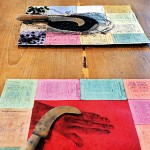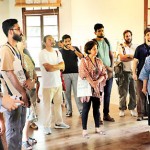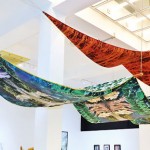Taking a walk through the ‘Way of the Forest’
View(s):- Colomboscope begins with free exhibitions at the J. D. A. Perera and the Barefoot Galleries with workshops, tours and more throughout the week
By Shannon Salgadoe
With all exhibitions free and open to the public from 10 a.m. to 7 p.m, from January 19-28, visitors can explore this year’s theme ‘Way of the Forest’ to gain insights into eroding ecological histories, lost environmental wisdom, political agendas, and the hope of regeneration from an artist’s perspective.
- U. Arulraj: Expressing legacy of forced labour in tea plantations
- Curated walk: Natasha Ginwala, Colomboscope’s Artistic Director explaining some of the exhibits
- ‘Pu Travers Sa Dilo’ : Eye-catching fabric installation by Shiraz Bayjoo. Pix by M.A. Pushpa Kumara
Along with the exhibits at the J. D. A Perera Gallery and Barefoot Gallery, ‘mushroomings’ – events such as workshops, film screenings, and interactive performances are spread out over the coming week. The festival curators and guest curators will conduct tours of both exhibition venues. (see the Colomboscope website for times).
The larger of the two exhibition venues, the J. D. A. Perera Gallery (the campus of the University of Visual and Performing Arts) has art spread out over three floors. An eye-catching fabric installation of London-based artist of Mauritian origin, Shiraz Bayjoo, takes up aerial space. Titled ‘Pu Travers Sa Dilo’ which translates as ‘to cross this water’ in Mauritian Creole, it explores the transfers and placements that have taken place in the Indian Ocean.
His creations also consist of seeds, pods, and shells atop wooden altars as memorials of survival and resistance in settlements of Maroon communities. “These focus on the network of botanical gardens which evolved with every diminishing moment of the indigenous forests they are extracted from,” explains the artist.
Sarmila Suriyakumar from Thirunelveli in Jaffna – a village known for wood carving – mixes the craft and her familial legacy of wood carving with nature. She uses teak and neem woods and combines them with Hindu practices of tying coins, cradles and cloths to sacred trees inside Kovils to pray for remedies and to recall the dead and disappeared. Sarmila collaborated with Pirainila Krishnarajah, a photographer and documentary-maker from Jaffna to research the role of tree worship further.
Artist Rakibul Anwar’s drawings depict the gradual metamorphosis of the once-verdant urban sector of Banasree and its current deterioration due to human encroachment while print artist Subas Tamang, artist Sanod Maharjan, and mixed-media artist Tamarra Jayasundera’s works offer different perspectives.
The venue also has interactive installations such as one by Bangladeshi artist Zihan Karim whose audiovisual installation reflects symbolism around the ‘all-seeing eye’ and omnipresent vision across civilisational and sacred culture while also looking at the forest through a sequence of dreams.
At the second exhibition venue, Barefoot Gallery, visitors encounter the thought-provoking work of U. Arulraj, who reflects on historical experiences of ecological devastation and systemic violence in tea plantations through the colonial periods. Coming from a family of estate workers, his works are surrealist compositions alluding to the legacies of forced labour, hierarchical management and restrictive architectures of daily life in the hills of Haputale. “Our people who have enriched the forests and hills have not owned even a single piece of land until today. At times they have been forced to go hunting. That is the extent of dispossession, but their ancestral guardianship remains steadfast,” he points out.
Bangladeshi artist Soma Surovi Jannat draws on inspiration from geography and water politics as well as 19th-century photography and print culture of Mughal miniatures in her explorative journey around the folklore of the Sundarbans, a mangrove forest in Bangladesh. Dumiduni Illangasinghe (our cover page picture) , a recent graduate from the University of Fine Arts in Colombo showcases an installation – the world of fungi, mycelia and spores, also indicative of regeneration through decay.
Interesting workshops will take place throughout the coming week. The Parrotfish Collective introduces participants to urgent conservation issues and how these can be communicated in an accessible manner while performance workshops by Venuri Perera and Eisa Jocson are also not to be missed.
Nahla Al Tabbaa, an artist, alchemist, and chef based out of Jordan explores the tensions between the urban and the organic, and the beautiful and the grotesque in her workshop ‘Alchemy in the Urban’. “I am sensitive to how materials have agency, and I work with them through my experiments with alchemy, food and drawing,” she says. “I grew up in a rural area of Jordan where flora, fauna and other aspects of nature, both good and bad, were my main teachers. I began to feel a sense of loss living in cities that I couldn’t quite pinpoint until my practice began to shift towards old-world practices of alchemy, cooking and herbal medicine.”
Another workshop will explore the role of fungi in an ecosystem and will touch on the potential of using fungi in different sectors. “Although we recognize the separation of the fungal kingdom, it is the web that binds all ecology together. Fungi were present long before us and will continue to occupy earth long after us,” says Dhanushka Jayanetti, a Regenerative Ecosystems Designer who will be conducting this immersive workshop.
‘I Am Because We Are’ by the Collective of Contemporary Artists (CoCA) offers young minds a chance to connect with nature through various fun and interactive activities to attune to the eight senses. Founded by Poornima Jayasinghe and Chinthaka Thenuwara, CoCA is Sri Lanka’s first pioneering art organisation which focuses on ecology-based, socially engaged and sustainable art forms and practices. “This holistic engagement with nature not only contributes to personal well-being but also instills a sense of responsibility for environmental conservation,” says Poornima.
All workshops require prior registration due to limited capacity. Visit https://www.colomboscope.lk/way-of-the-forest for more information.
Searching for that next furry family member but couldn’t find one in your area? Hitad.lk has the solution with our extensive listings of dogs for sale in Sri Lanka!





